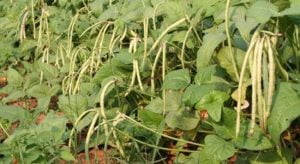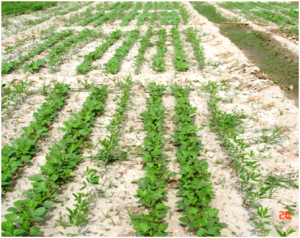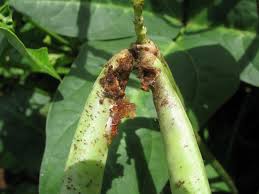Chawli is cultivated as a cereal crop. In India, it is also called Chaula and Chaura. Its raw beans are used for making vegetables. Apart from vegetables, grains are used in many ways in food. Chawli is also used as animal feed. Before the seedlings mature, the field is plowed to make green manure.
In India, sorghum is grown mainly in Tamil Nadu, Madhya Pradesh, Karnataka, Rajasthan, Kerala and Uttar Pradesh. Its seedlings do not need much rain to grow. Its plants retain moisture in the soil. Its trees are found in both shrubs and shrubs. Its beans are up to 1.5 feet long. Dry weather is essential for its growth.
If you are also thinking of cultivating it, today we are going to give you complete information about its cultivation.
Suitable soil
Chawli can be grown in light, heavy, sandy, loamy soils of almost all types. But water conservation should not be a problem for its cultivation. This is because in case of water retention, the plants cannot grow and fall prey to the disease. The pH of the soil for its cultivation. The value should be between 6 and 8.
Climate and temperature
Cultivation of sorghum requires temperate climate. The hot climate is conducive to the cultivation of sorghum. But extreme heat also affects the growth and yield of its plants. Its seedlings cannot grow in winter. Excessive rainfall is not suitable for its cultivation.
The initial temperature required for germination is around 20 degrees. After germination, the plants grow easily even at a temperature of 35 degrees. And temperatures below 15 degrees are detrimental to its cultivation. Its plants grow well at normal temperatures.
Improved varieties
There are many types of chewing gum. Which farmers produce for different purposes.
Kashi Unnati
This variety of Chawli is taken as an early crop. Trees of this species are dwarf shaped. Green beans are ready for harvest 40 to 50 days after planting. The yield per hectare is around 150 quintals. Its cultivation is suitable for green beans.
Gold
A special feature is found in the plants of this species. Legumes grow on its seedlings. Whose stalk length is also longer. This makes it easier to harvest soybeans. Its beans are ready to ripen in about 110 days. Its seeds look red. The yield of this species is estimated to be around 25 quintals per hectare.
c. 152
Cultivation of this variety is good for green fodder. But if it is harvested for its grain production, its plants are ready to ripen in 100 to 110 days. The yield per hectare is 15 to 20 quintals. This variety is widely grown in Central and North India.
Pusa rain

Chawli is an early crop grown by farmers in the plains of northern India. Its trees are dwarf shaped. Its seedlings are ready to take out green beans about 45 to 50 days after sowing. The yield per hectare is around 100 to 150 quintals.
Pant beans – 4
Chavali trees of this species are found around one and a half to two feet tall. Plants of this variety are ready for harvesting after 60 to 65 days after sowing. This variety is cultivated as an early crop. The beans of this variety are found to be about half a foot in length. Its seeds look white. The yield is around 15 to 20 quintals per hectare.
Chawli 263
The seedlings of this variety can be planted in both kharif and rabi seasons. Which are planted as an early crop. Plants of this genus are ready to produce the first green pods in about 40 to 50 days after sowing. The yield per hectare is around 125 quintals. Viral diseases are rarely found in this type of plant.
Arch amplitude
This variety is cultivated mainly in monsoon season. The trees of this species are two and a half to three meters long. Trees of this species grow in the form of vines and develop on their own. Its pods are light green in color. Whose length is found between 15 to 20 cm. About 80 quintals per hectare of green soybean is produced from this variety. The seeds are ready to ripen in about 40 days after planting.
Mango
Seedlings of this variety are ready for harvest 100 days after sowing. This type of grain looks red. The yield per hectare is 25 to 30 quintals. Viral and insect diseases are rarely seen on these types of plants. This variety is mainly grown as kharif crop.
Apart from this there are many other types available in the market. Which farmers produce on the basis of different seasons. These include RC-101, Russian Joint, Pusa Komal, C.-278, Hissar Lobia-46, PKB-4, Pusa Rituraj, GFC-1, V-240, Jawahar Lobia-21, Pusa Sampada and Bandal. . Chawli-1.
Farm preparation
Remove old crop residues from the field while preparing the field for sorghum cultivation. After that, the field should be left open for a few days after deep plowing by inverted plowing. Then the old manure of the field should be mixed in the form of organic manure.
Two to three sloping plowing should be done by field tillage to mix the fertilizer in the soil. After that, water the field and thresh the field. After three to four days of plowing, when the soil in the field starts to dry out, rotate the field with a rotavator. And then the field should be leveled by plowing. So that there is no problem of water storage in the field during monsoon.
Seed dosage and treatment
Process the chawli seeds before germination in the field so that the seeds germinate well. Appropriate doses of Thiram, Carbendazim or Capt. Dawa should be used for seed treatment. It takes 25 to 30 kg of seed per hectare to cultivate sorghum. For green fodder and green manure cultivation 35 to 40 kg of seed is required.
Method and timing of seed sowing

If you are cultivating sorghum for green fodder or green manure, it is better to use sprinkler method. For this, first sow the seeds in the field. After that light plowing should be done twice with the feet tied behind the farmer. So that its seeds mix well in the soil.
In order to produce sorghum, it is planted in rows on the mead. When planting in rows, its seeds should be sown at a depth of 4 to 5 cm. Therefore, seed germination is not affected. When sowing seeds, spacing should be 2 feet between seedlings for spreading seedlings and 1 foot spacing for shrubs growing in the form of shrubs. And the distance between the beds should be 10 to 15 cm.
Chawli is cultivated all over India during both kharif and rabi seasons. It is grown as a kharif crop in northern India. In the meantime, its seeds are sown in June. In South India it is grown as a rabi crop. Meanwhile, seeds are sown in October and November during the rabi season. Apart from this, it is also grown in hilly areas in March.
Irrigation of plants
Chawli trees do not require much irrigation. But the production of green soybeans during summer season requires more irrigation. In the meantime, it is best to water the plants once a week. This results in better growth of plants and higher yields.
The kharif season requires very little water for its production. During this time only two to three waterings should be given as per the requirement of the plants. It is best to water the plant at intervals of 10 to 15 days during rabi season.
Fertilizer quantity
Chawli trees need moderate amount of fertilizer. For this, initially 12 to 15 carts of old manure should be sprayed in the form of organic manure per hectare and mixed in the soil. In addition, two bags of NPK are used as chemical fertilizer. This amount of spraying should be done during the last plowing of the field. When buying NPK, buy NPK with low nitrogen content. This is because the plants themselves supply nitrogen to the soil.
Weed control
Weed control in sorghum cultivation can be done by both chemical and natural methods. For chemical weed control apply appropriate amount of pendimethalin in the field immediately after sowing. Therefore no new weeds are born in the field. And even if they are born, their proportions are much lower.
Weeds are controlled by removing weeds from the trees in a natural way. The first weeding should be done about 20 to 25 days after sowing. After the first pot, the rest of the pot should be done at intervals of 15 days. Two to three trunks are enough for a chawla tree.
Plant diseases and their prevention
Many types of pests and viral diseases are found in chawla trees. If they are not taken care of in time, there will be huge loss in production.
Bacterial side effects
The disease is observed in seedlings during germination. In developed plants, the disease first appears on new leaves and twigs. The disease causes significant damage to the product when it appears on the plants in the early stages. Initially, the leaves of the sprouted tree turn red and begin to shrink after the disease. During the growth of the plant, dry spots form on the new leaves in case of disease. As the disease progresses, the whole plant dries out and dies. Proper amount of oxychloride should be sprayed on the seedlings to control this disease.
Mhow
The effect of Mhow disease on chawla trees is seen during plant development. The pests of this disease absorb the sap of the soft parts of the plants and stop their growth. Insects of this disease are small in size and appear black, yellow and red in color. Outbreaks appear to be exacerbated during this time. Its effect is more visible on income. Imidachloroprid or methyl dimeton should be sprayed on the plants in proper quantity to control the disease.
Pod borer

Peanut borer disease in sorghum cultivation causes great loss of its production. The larvae of this disease sting its pods and eat the seeds. So its caterpillar lives in the leaves of the tree and eats its flowers and leaves. It also stops the growth of the plant. When the disease grows in plants, there is a large loss of production. Apply neem oil, quinalphos or methyl parathion powder in appropriate quantity to control the disease.
Chawli mosaic
Yellow spots appear on the leaves of the tree after the onset of the disease. As the incidence of the disease increases, the leaves of the tree turn yellow. And boil-like shapes begin to form on the leaves. As a result, the peat dies. Dimecran or Metacystox should be sprayed on the plants in appropriate quantity to control the disease.
Romil Sundi
Romil larvae cause extensive damage to Libyan agriculture. Its attack on the trees is more visible at the beginning. The caterpillars of this disease initially destroy the tree by cutting it down. This affects the growth of plants. And the income is also very low. To prevent this disease it is best to spray chlorpyrifos or quinolphos twice a day at 10 day intervals.
Harvest Harvest
When harvesting raw green beans, the seedlings are ready for harvest 40 days after sowing. It should be harvested before ripening. When it is harvested in the form of grain, its seedlings are ready for harvest about 100 to 110 days after sowing.
Meanwhile, when the leaves of the tree turn yellow and the soybeans turn black. The seedlings should then be cut off from the soil surface and collected in the field for a few days to dry in strong sunlight. Then when the seedlings are well dried, the seeds should be removed by thresher.
Income and profit
Chawli is cultivated for green soybeans and grains. The average yield of different varieties of green soybean is about 125 quintals. Its production in the form of grains is about 20 quintals. Whose market price is good. Therefore, farmers can earn more profit from farming at lower cost.







